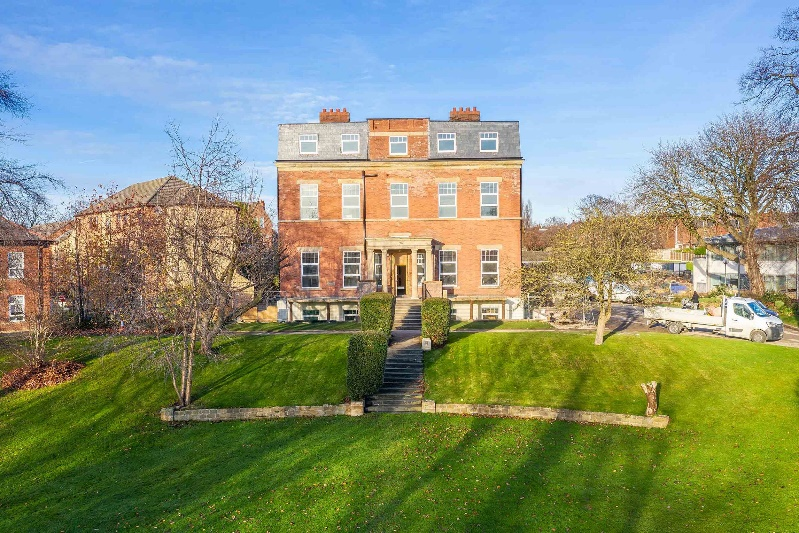News
MANYGATES WAKEFIELD - RESIDENTIAL DEVELOPMENT
15 February 2021

Tri-Core Developments are nearing completion on a 16 unit residential scheme in Wakefield. The existing building was built in 1849 for a former butchers son and was later turned into a Maternity Hospital and also formed part of a University Campus.
THE HISTORY OF MANYGATES
Having laid derelict for more than a decade, construction has begun on the conversion of Manygates Maternity Hospital in Wakefield. Fondly remembered by the healthcare professionals who trained and worked there, as well as by countless locals for whom the site was their very first contact with the outside world, the hospital site began its journey with the construction of Manygates House in 1849.
Edward Green, known as ‘Old Neddy’, was a butcher’s son, born in Wakefield in 1799. He made his fortune during the Industrial Revolution and by 1821 had founded his own company “E. Green and Son” and by 1845. Edward had patented designs for the ‘Economiser’ boiler; an innovation which recycled heat waste from boilers which was paramount to producing fuel-efficient systems- aspects of which are still used to this day.
Manygates House was built by Edward Green in 1849, just as business was booming.He moved in with his wife, Mary, and their three children; Martha, Samuel and Edward Jr.
MANYGATES MATERNITY HOSPITAL
Accommodating the comings and goings of various families over the years, it was around 1930 that the function of Manygates House changed. Alterations were made to transform the mansion into doctors’ quarters for a new purpose-built maternity hospital.
Replacing the Wakefield Corporation Maternity hospital on Blenheim Road, Manygates Maternity Hospital was opened by the mayor in 1935 and was built at a cost of £27,000- almost £2,000,000 in today’s value. The hospital, child welfare centre and antenatal clinic grounds covered an area of nine acres and when first opened accommodated 35 patients. At a time before the creation of the NHS, the government was aiming to address the high rates of infant and maternal mortality. A voluntary group called ‘The Babies’ Welcome’ had been founded in Wakefield nearly 30 years before the opening of Manygates Hospital to such success that copycat schemes had been used in surrounding areas such as Armley, Leeds. Since the start of the scheme, infant mortality had decreased to less than one third of what it was thirty years before. However, maternal mortality was still a big problem and this was acknowledged in a speech by a Mr A Greenwood at the hospital’s opening ceremony: “Maternal mortality is the most stubborn problem we have to face. Despite the fact that we have enormously improved the physique of our children, and reduced the death rate in recent years, we are still left with what I believe to be the ugliest social factor today.”
Throughout the baby boom years, Manygates Hospital was expanded to accommodate the growing needs of Wakefield and its surrounding areas. In 1956, bed capacity increased to 80 and there were yet more extensions made in 1966. An annual garden party was held in the grounds of the hospital, hosting around 200 former patients - raising funds for the Wakefield and District branch of the Royal College of Midwives.
Manygates hospital closed on the 12th December 1992 as maternity services were transferred to Pinderfields Hospital. In 1995, the hospital was purchased by Bretton Hall College, a teacher training institute which held international acclaim for its specialities in design, music and the performing arts. Manygates Campus was modified to provide student accommodation and became an atelier space and study hub for the college’s social work and counselling department, hosting 250 students. In 2001, Bretton Hall College merged with Leeds University and in 2007 the campus, including its Manygates branch, closed.
Accommodating the comings and goings of various families over the years, it was around 1930 that the function of Manygates House changed. Alterations were made to transform the mansion into doctors’ quarters for a new purpose-built maternity hospital.
DERELICTION OF MANYGATES
Since 2007, Manygates has laid derelict and open only to the curious Urban Explorer. Urbex videos and images document dilapidated corridors, rubble-filled rooms and walls peeling with layers of old paint. With such a rich history, it’s no wonder that so many have been drawn to have a look inside.
THE NEW CHAPTER OF MANYGATES
Planning was approved for the change of use and refurbishment of Manygates into 16 units in 2006 however following the completion of the new build units Manygates laid dormant for another 14 years. PARKdesigned were engaged by Tri Core Developments in 2020 to kick-start the project back into life by discharging the planning conditions and producing the technical information.
Before construction could begin the building had to be made safe. After being left untouched for many years the existing roof, floors and some walls had collapsed. The building was so bad that it was unsafe to undertake a current measured survey.
Following a quick turnaround of information by PARKdesigned, Tri Core Developments were able to start on-site turning the building back into the landmark of Wakefield it once was.
Trusted Building Contractors | Yorkshire Builders | Tri-Core Developments (tri-coredevelopments.com)